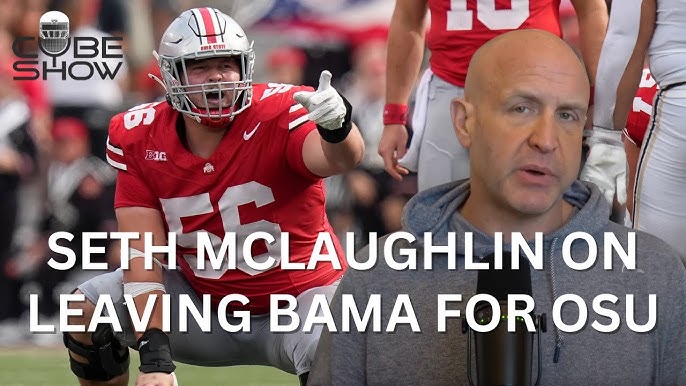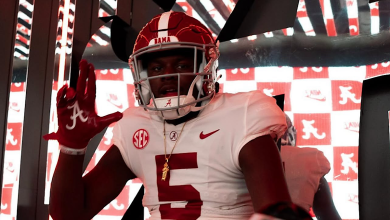The unexpected rationale behind Seth McLaughlin’s transfer from Alabama to Ohio State

The Unexpected Rationale Behind Seth McLaughlin’s Transfer from Alabama to Ohio State
In the ever-evolving world of college football, the transfer portal has emerged as a significant game-changer. Players, coaches, and fans alike are becoming increasingly familiar with the idea of athletes switching schools, sometimes even unexpectedly. The transfer portal allows athletes to change institutions while maintaining their eligibility, and this shift has led to dramatic changes within college football programs across the nation. One such high-profile transfer was that of Alabama center Seth McLaughlin, who, after years of development and contributing to the Crimson Tide, made the surprising decision to transfer to Ohio State. His move raised many eyebrows, considering his established role at Alabama and the expectations surrounding him. The reasons behind McLaughlin’s transfer are layered, and understanding the factors involved requires a closer look at personal, professional, and programmatic elements.
The Rise of Seth McLaughlin at Alabama
Seth McLaughlin’s journey at Alabama is one of steady progression and growing importance within the program. A native of Georgia, McLaughlin was a highly regarded offensive lineman coming out of high school. Standing at 6’4″ and 305 pounds, McLaughlin possessed both the size and skillset required to succeed at the collegiate level. His recruitment to Alabama was a recognition of his potential to become a key contributor to a program that places a premium on offensive line play.
Over the years, McLaughlin worked his way up the ranks at Alabama, eventually becoming a starter at center in the 2022 season. His versatility and ability to adapt to Alabama’s complex offensive schemes earned him praise. His role as a starting center was particularly significant, as Alabama had been in search of a leader on the offensive line to anchor their offense, and McLaughlin had the physical and mental traits necessary for the job.
Throughout his tenure, McLaughlin was known for his leadership, work ethic, and consistent performance. Under offensive line coach Eric Wolford, McLaughlin showed both skill and intelligence, calling out protections and ensuring that the offensive line operated cohesively. His ability to perform at a high level, especially in high-pressure SEC games, cemented his place as one of the key cogs on the Alabama offense.
However, despite his success, McLaughlin’s story at Alabama was about to take an unexpected turn. In the middle of the 2024 offseason, McLaughlin made the surprising decision to enter the transfer portal and later commit to Ohio State. The move raised several questions: why would a player who had been a staple of Alabama’s offensive line decide to leave such a prestigious program? What factors contributed to his decision? And how would this transfer impact both Alabama and Ohio State moving forward?
The Competitive Landscape at Alabama
One of the most plausible reasons behind McLaughlin’s decision to transfer relates to the intense competition for playing time within the Alabama football program. Alabama, under head coach Nick Saban, is known for its depth and talent at nearly every position, but this depth often comes with a downside. Competition for starting roles is fierce, and despite McLaughlin’s previous success, the arrival of new recruits and the development of other players on the roster meant that his spot on the field was not guaranteed.
In the 2024 offseason, Alabama welcomed a highly touted class of offensive linemen, many of whom were expected to challenge for starting positions. Among them was elite recruit Jalen Chapman, a five-star offensive lineman who had been billed as one of the top players in the 2024 class. While McLaughlin had been a reliable starter for Alabama, the emergence of such high-profile recruits could have put his future playing time in jeopardy. For McLaughlin, the fear of losing his starting role, especially in his final years of eligibility, might have been a significant motivating factor in his decision to transfer.
At Ohio State, McLaughlin saw an opportunity to step into a more prominent role. Ohio State has a history of developing top-tier offensive linemen, and the Buckeyes’ system places a premium on strong, experienced centers to lead their offense. For McLaughlin, the chance to play for a program with an established reputation in the Big Ten and a solid path to the NFL could have been an enticing factor in his decision. The opportunity to play for a program that values his position and allows him to continue his development might have outweighed his loyalty to Alabama, especially given the uncertainty surrounding his role there.
Coaching Changes and Philosophical Shifts
Another factor that likely played a role in McLaughlin’s transfer is the changes in Alabama’s coaching staff and the resulting shifts in offensive philosophy. After the 2023 season, Alabama made several changes to its coaching staff, including a new offensive coordinator and offensive line coach. These changes brought with them a different approach to how the offensive line would be utilized and the overall offensive scheme that would be implemented.
Nick Saban’s decision to bring in a new offensive coordinator marked a shift in Alabama’s approach to offensive football. With more emphasis being placed on versatility, speed, and the passing game, McLaughlin may have found that his skills as a traditional, powerful center were less aligned with the direction in which the program was headed. Coaches and players have to align on both a technical and philosophical level for success, and sometimes, players may feel that they are no longer the perfect fit for a system. If McLaughlin felt that his style of play—powerful, run-blocking centered on physicality—was not as valued in Alabama’s evolving offensive system, he may have sought a program where his strengths would be utilized more effectively.
Ohio State, under head coach Ryan Day, has been known for its ability to balance both a high-powered passing attack and a strong, physical ground game. The offensive line is crucial to the success of this system, and the Buckeyes consistently recruit and develop linemen who excel in both the running and passing game. This shift could have represented a more comfortable fit for McLaughlin, one where his skills as a versatile and experienced center would be both appreciated and maximized.
Family and Personal Considerations
Beyond the football field, McLaughlin’s decision to transfer may also have been influenced by personal or family factors. College athletes often make decisions based not just on football, but on how their situation impacts their well-being, academics, and overall life. McLaughlin’s move to Ohio State could have been motivated by a variety of personal reasons, including closer proximity to family, a desire for a new environment, or an academic program that better suited his future plans outside of football.
While McLaughlin had established himself at Alabama, the opportunity to experience a different part of the country, engage with a new team culture, and perhaps explore academic opportunities in a new setting may have played a significant role in his decision. It’s important to remember that these athletes are young individuals who are making decisions that impact not just their football careers, but their personal lives as well. McLaughlin’s transfer could reflect a combination of these personal considerations alongside the football-related factors.
Ohio State’s Appeal: A New Challenge
Ohio State presents a unique appeal for any player looking to make a significant impact. The program has been a perennial contender for the College Football Playoff, and the Buckeyes consistently produce top-tier talent, especially in the trenches. Ohio State’s offensive line has long been a hallmark of the program, and the team’s ability to produce NFL-caliber linemen is a strong selling point for any prospective recruit.
For McLaughlin, joining Ohio State allowed him to continue playing at a high level of competition, with the added benefit of stepping into a new challenge. The Buckeyes’ offensive line has been known for producing elite centers, and McLaughlin could have seen this as an opportunity to further develop his skills and potentially improve his NFL draft prospects. Additionally, playing in the Big Ten, where teams like Michigan, Penn State, and Wisconsin emphasize physical football, could provide McLaughlin with a different style of competition and help sharpen his overall game.
In the end, McLaughlin’s decision to transfer was likely influenced by a combination of competitive, professional, personal, and programmatic factors. While it may have initially been shocking to see a player of his caliber leave Alabama, the reality is that McLaughlin was presented with an opportunity that aligned more closely with his long-term goals—both on the field and off.
The Impact on Alabama and Ohio State
McLaughlin’s departure is a loss for Alabama, as the program must replace a reliable starter and leader on the offensive line. However, given Alabama’s depth and recruiting prowess, the program is likely to bounce back quickly, finding a suitable replacement and continuing to compete at the highest level. Meanwhile, McLaughlin’s arrival at Ohio State fills an immediate need for an experienced center and further solidifies the Buckeyes’ offensive line for the 2025 season. His decision strengthens Ohio State’s pursuit of a Big Ten title and a potential spot in the College Football Playoff.









